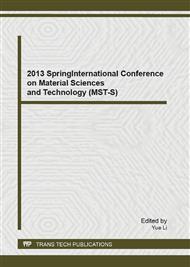[1]
M. Gerhard, The research for low-k and ultra-low-k dielectrics: how far can you get with polymers, IEEE electrical insulation magazine 20 (2004) 6-24.
DOI: 10.1109/mei.2004.1307082
Google Scholar
[2]
P.S. Ho, Overview on Low Dielectric Constant Materials for IC Applications, Germany, berlin: Springer, (2003), 3-11.
Google Scholar
[3]
P.J. Wolf, Overview of dual damascene Cu/low-k interconnects, International sematech 14 (2003) 125-141.
Google Scholar
[4]
S. Fu, K.J. Qian, S.J. Ding, Preparation and Characterization of Ultralow-Dielectric Constant Porous SiCOH Thin Films Using 1,2-Bis(triethoxysilyl)ethane, Triethoxymethylsilane and a Copolymer Template, J. Electron. Mater. 40 (2011) 2139-2146.
DOI: 10.1007/s11664-011-1721-y
Google Scholar
[5]
H.Y. Lu, C.L. Teng, Addition of surfactant tween 80 in coating solutions for making mesoporous pure silica zeolite MFI low-k Films, Ind. Eng. Chm. Res. 49 (2010) 6279-6286.
DOI: 10.1021/ie100203e
Google Scholar
[6]
F.K Thije, A.R Balkenede, Structural characterization of mesoporous organ silica film for ultra low-k dielectrics, J. Phys. Chem. B. 107 (2003) 4280-4289.
Google Scholar
[7]
S.M Kim., D.Y. Yoon, C.V. Nguyen, Experimental and theoretical study of structure-dielectric property relationships for polysilsesquioxanes, Mater. Res. Soc. Symp, Proc. 511 (1998) 39.
DOI: 10.1557/proc-511-39
Google Scholar
[8]
R. Hoofman, G. Verheijden, J. Michelon, Challenges in the implementation of low-k dielectrics in the back-end of line, Microelectron. Eng. 80 (2005) 337-344.
DOI: 10.1016/j.mee.2005.04.088
Google Scholar
[9]
K. Maex, M. Baklanov, D. Shamiryan, Low dielectric constant materials for microelectronics, J. Appl. Phys. 93 (2003) 8793-8841.
DOI: 10.1063/1.1567460
Google Scholar
[10]
S. Yang, P.A. Mirau, C.S Pai, Nanoporous ultralow dielectric sonstant organosilicates templated by triblock copolymers, Chem. Mater. 14 (2002) 369-374.
DOI: 10.1021/cm010690l
Google Scholar
[11]
K.H. Kohmura, S.O Tanaka, Novel organosiloxane vapor annealing process for improving properties of porous low-k films, Thin solid films 14 (2007) 5019.
DOI: 10.1016/j.tsf.2006.10.054
Google Scholar
[12]
K. Banerjee, A. Amerasekera, The effect of interconnect scaling and low-k dielectric on the thermal characteristics of the IC metal. technical digest IEEE International electron devices meeting, 8-11 (2008) 65-68.
DOI: 10.1109/iedm.1996.553123
Google Scholar
[13]
T.G. Tsai, A.T. Cho, C.M . Yang, Formation and microstructure of mesoporous silica films with ultralow dielectric constants, J. Electrochem. Soc. 149 (2002) F116-F121.
DOI: 10.1149/1.1499502
Google Scholar


